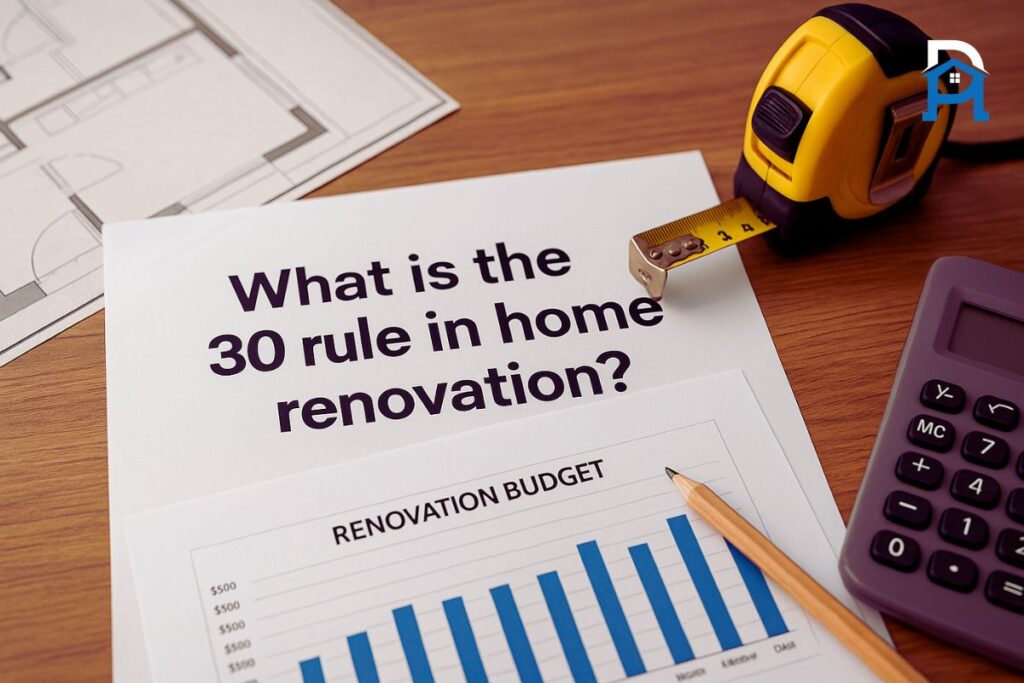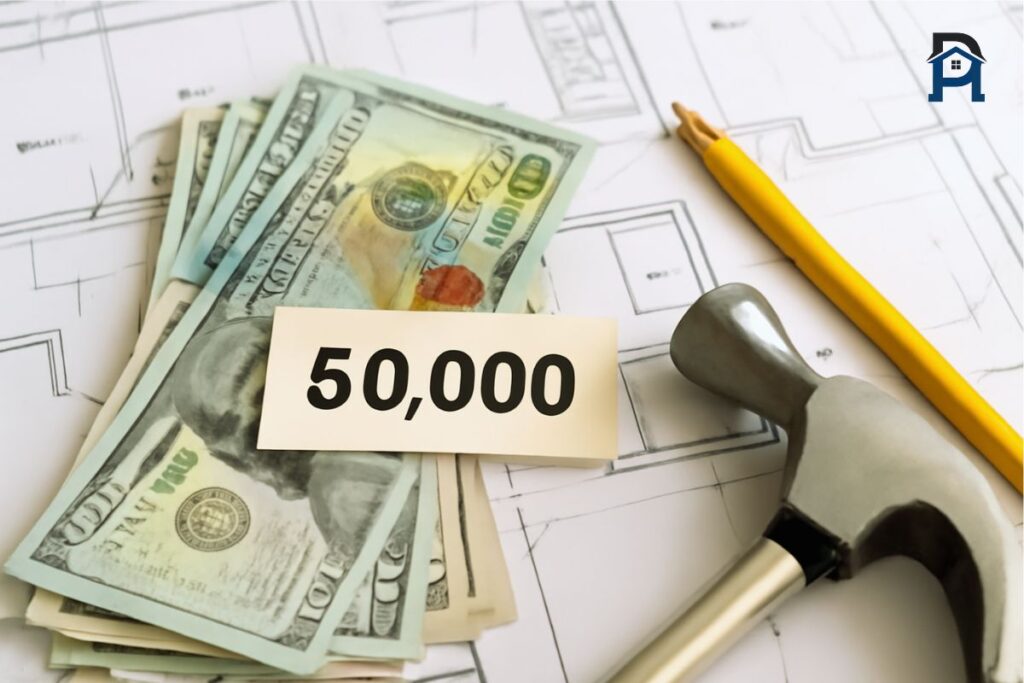When planning a home remodel, it’s easy to get excited and dream big—but many first-time homeowners quickly feel overwhelmed by surprise costs and endless choices. That’s where the 30% rule comes in. More than just a number, it’s a smart planning tool that keeps your renovation budget in check and helps you focus on what really matters.
The idea is simple: don’t spend more than 30% of your home’s current value on renovations. For example, if your home is worth $300,000, aim to cap your renovation budget at $90,000. This helps protect your equity, avoid overspending on flashy features, and boost your chances of a strong return if you decide to sell.
This doesn’t mean cutting corners—it means investing wisely. Prioritize updates that offer real value like improved functionality, curb appeal, and layout. In my experience, clients who follow this approach make better decisions and end up with spaces that feel both smart and stylish.
Whether you’re planning to stay or preparing to sell, the 30% rule helps you upgrade with confidence, avoid financial strain, and get the most from your renovation.
Key Takeaways for Every Homeowner
- Keep your renovation budget within 30% of your home’s current value to stay financially healthy and avoid spending too much.
- Use online valuation tools and sales data from similar homes to get an accurate budget for your project.
- Always confirm your findings after getting a professional appraisal to ground your plans in real market values.
- Concentrate on upgrades with the best return, like modern kitchens and updated bathrooms, since these features catch buyers’ attention.
- Invest first in upgrades that increase your home’s value, not purely cosmetic fixes that might not pay off.
- Even in hot markets, don’t exceed the value threshold unless you’re certain the change will increase your property’s worth.
- A careful planning phase will help you estimate costs more accurately and avoid overspending.
- Sticking to these guidelines means your renovation choices will be smart, practical, and in line with your long-term vision.
Redefining the 30% Rule: A Practical Guide for Budget-Savvy Homeowners
After nearly a decade in home improvement, I’ve seen the 30% rule become a go-to strategy for homeowners who want smart, effective renovations. The idea is simple: spend no more than 30% of your home’s current market value on updates. This keeps your finances in check while allowing room for creativity and comfort.
But this rule goes beyond budgeting—it helps convert your vision into results that feel both practical and inspired. Whether updating your kitchen, preparing for resale, or just enhancing everyday living, the 30% cap helps prioritize value over luxury. It steers you away from overspending on upgrades that might not boost your property’s worth.
I’ve worked with clients who nearly blew their budgets chasing features the market didn’t reward. The 30% rule acted like a soft stop—reminding them to focus on updates that truly matter. With smart planning, and help from trusted partners like Primework, you can tailor the rule to fit your goals without overshooting your finances.
Use this rule as a flexible blueprint. Make thoughtful choices, know when to pause, and design a space that reflects both your lifestyle and long-term value. That’s the real power behind this renovation strategy.
The True Benefits of Following the 30% Rule in Renovation
Sticking to the 30% rule isn’t just good planning—it’s a whole new way of thinking that shields your wallet, eases your stress, and helps protect your home’s value. After years in the field, I can tell you the most common blunder I see is people diving into a project without knowing the money boundaries they must honor. The 30% rule acts like a safety rail, guiding you whether you’re sprucing up a kitchen or overhauling the whole layout.
Here’s why the rule matters, explained in day-to-day terms:
1. Financial Security
The first big payoff is security. I’ve watched clients walk in after a blown budget—costs spiraled because they followed their emotions or overlooked a hidden fee. By respecting a clear ceiling, you dodge pricey loans and keep your money balanced. Renovation can certainly cost, but it doesn’t have to sink your finances. This is a lifesaver for anyone juggling several properties, or for those on a tight budget.
2. Maximizing Return on Investment (ROI)
I always tell my clients: smart renovations boost value without overspending. If you want the biggest bang for your buck, this principle is your north star. Focus on the kitchen, bathroom, or thoughtful upgrades like energy-efficient windows, and you’ll see the numbers climb. These projects add lasting charm without breaking the bank. Even a small, intentional outlay—when above-board and targeted—can deliver a hefty ROI without runaway costs.
3. Prevents Overcapitalization
One of the best, yet least celebrated, perks of this principle is its guard against overcapitalization. It’s all too easy to sink cash into upgrades your neighborhood can’t support. I see it happen: owners pour money into fancy finishes that the local market won’t reward, and the margin shrinks. The 30% rule keeps your choices grounded, keeps the upgrades relevant, and keeps the property within competitive reach. It limits losses and shields your bottom line by keeping renovations in line with the property’s real worth.
In a nutshell, sticking to the 30% rule is more than saying no; it’s saying yes to better, more strategic decisions that help you reach your long-term vision.
Using the 30% Rule to Guide Your Home Renovation
Putting the 30% rule to use is about more than crunching the numbers. It’s about creating a solid plan that aligns your financial limits with your vision for the space. Over the years, I’ve helped homeowners turn numbers into action by combining discipline with a clear step-by-step process. Here’s how to make the rule work for you while keeping your budget—and your goals—on the same track.
1. Find Your Home’s Present Market Value
Start by figuring out what your home is worth right now. You can use reliable online valuation tools, or you can partner with a real estate agent or a licensed appraiser. They’ll analyze the latest sales in your neighborhood and provide a value based on real data. Once you have that number, you can quickly calculate 30% of it, which becomes the financial limit for your renovation. Ignoring this step leaves you with guesses, and in the world of home improvements, guesses can turn into costly surprises. A solid, updated market value gives your renovation a firm financial foundation and keeps your project aligned with your home’s overall value.
2. Allocate Your Budget Wisely
Now that you know how much you can spend, you need to divvy that cash up smartly. The goal is to steer clear of waste and zero in on repairs that matter most. First, tackle leaks, structural issues, old plumbing, and any unsafe electrical stuff. These fixes are musts for safety and long-term value. After that, pour money into the bathrooms and kitchen; they almost always give you more money back when you sell.
Pass on flashy stuff like in-home theaters and custom features that are pricey and rare for your area. I’ve seen folks lose interest in homes that are over-the-top for the neighborhood. Stay away from over-customization, and spend your dollars on things that save energy, stylish finishes, or materials that give you more bang for your buck. This kind of smart plan pays off now and when you sell later.
3. Prepare for Unseen Costs
No matter how careful you are, surprises can still pop up during a renovation. That’s why I always tell clients to pad their budgets with a cushion for these out-of-the-blue costs. It could be a small pipe leak, an unexpected electrical repair, or a sudden jump in material prices. Having that extra money ready keeps your project on track and your timeline intact.
Instead of dipping into your main savings or cutting corners, you can adjust with confidence. You also give yourself room to decide how to fix the problem without losing value or changing your original vision. The savviest homeowners I know set a target for the dream space but choose to be flexible. This way, they keep moving forward, no matter what the renovation throws at them.
Practical Considerations When Following the 30% Rule
1. Regional Differences in Property Values
The 30% rule is a solid starting point, but I’ve found that real-life application can differ a lot depending on where you’re investing. I’ve guided clients in both upscale and more modest neighborhoods, and a cookie-cutter approach rarely works. Property values can swing wildly from one market to another, so the same guideline can feel perfect in one area and off the mark in another. In some hot residential pockets, where buyers expect top finishes, a renovation budget can easily stretch past the 30% cap, especially if you’re upgrading luxury features. Contrarily, in more modest neighborhoods where 20% returns are the target, even a small budget overshoot can turn that 20% into a loss. Because of this, it’s key to know your local market, evaluate what’s right for your specific property, and stay willing to adjust the rule as needed.
2. Think About Your Future Goals
Your long-term vision matters just as much as your immediate needs. When people ask me for renovation advice, I always start by having them spell out their plans. Are you planning to call this place home for many years, or is a quick resale your main move? That answer will guide your renovation choices and your spending. If you intend to stay, feel free to add personal touches that bring you joy—even if those updates don’t promise the highest return. But if your sights are set on resale, concentrate on the essential fixes that will catch buyers’ eyes and boost your future profits.
3. Explore Cost Savings Strategies
Keeping costs under control can often feel like a juggling act. Here’s what I do: I look for high-value materials right off the bat. WPC tubes, moisture-resistant WPC ceilings, and mold-proof plaster boards stand out because they’re tough, they look good, and they outlast cheaper options. I find I can strengthen a renovation’s overall finish while also pushing the lifespan.
Instead of ripping everything out, I drill down on what really needs a change. Refurbishing a surface or a frame can deliver the same polished look for far less. I also make it a point to gather a handful of quotes from trusted suppliers. I stack their prices, their service records, and their material grades next to one another, and I study the fine print.
Details like decorative moldings, WPC wall panels, and solid wood veneers may seem small, but they can shift the final bill. I’ve had projects where swapping one panel for another brought the budget down without losing any visual punch. For the DIY-minded, I suggest tackling ceilings, wall skins, or punch-out repairs. Get those right and you can drive costs down while keeping the finished product solid. When I tie all these threads together, the outcome is a project that nails the look I want and sits comfortably within the wallet.
The 30% Rule: Where It Came From and Why It Matters
The 30% rule has its roots in classic real estate wisdom. It was designed to help homeowners stay in control of their budgets and their equity. Spend more than 30% of a home’s current market value on upgrades, and the calculations can start to tilt against you. Staying under that threshold lowers the odds of over-improving and helps you make renovations that truly pay off.
Here’s a quick timeline of how the rule grew:
| Year | Key Development |
| 1980s | Emergence of renovation guidelines |
| 1990s | Adoption by real estate professionals |
| 2000s | Widespread homeowner awareness |
| 2010s | Integration into renovation strategies |
The 30% rule gives you a clear target. It helps you balance necessary updates against the actual value a market will pay. Decades of use show it works: the rule helps you steer clear of money pits and keeps your renovation on the value-adding track.
How to Figure Out What Your Home is Worth Right Now
Before you think about the 30% rule, you have to know what your home is worth today. You can start with online estimate tools to get the basics, then look for recent sales nearby and for homes like yours that have the same size, age, and features. If you want to be really sure, contact a real estate agent or set up a formal appraisal.
A good realtor knows the local market and can explain what the latest trends mean. They can tell you if eco upgrades, a new kitchen, or even a stylish front door can boost your home’s value. Remember, the value also depends on the overall economy, how many buyers are looking, and what the neighborhood is like.
Combining the latest data with expert advice will give you a clear picture of your home’s worth. From there, you can create a sensible renovation budget that matches its market value.
Budgeting for Home Renovations Made Easy
To nail the popular 30% rule for renovations, kick things off with a solid plan and break your budget into bite-sized chunks. I always tell folks to take a step-by-step approach. List out the costs for materials, labor, and any permits you’ll need. Start by checking your home’s current value, then figure out the maximum you can spend. Just make sure that number stays under the 30% cap.
Zero in on the most important spots first, like the bathroom or main living area. This keeps your investment solid and boosts value for years to come. Keep your hopes grounded and know your financial limits early on. This mindset helps you dodge budget surprises later. Also, don’t skip the emergency fund—stash away 10% to 15% of your budget for those “oops” costs.
Partnering with a top-notch remodeler or seasoned contractor makes a difference, whether you’re flipping for profit or just want a cozy home. A smart budget keeps the project moving and your wallet happy.
Define Your Renovation Goals
Start by writing down your renovation goals. Are you redoing your whole house, or just freshening up the kitchen or bathroom? Being clear about what you want to do will keep the project on track and save you time and money. I’ve noticed that homeowners who set specific goals from the start end up with the results they imagined, rather than just a bunch of changes that don’t quite fit.
Research Costs
Once your goals are clear, dig into the numbers. Look up the typical costs for the kind of renovation you have in mind. If you know how much similar projects usually run, you can choose wiser materials and decide how big or small the project should be without going overboard.
Get Estimates
Next, reach out to several trusted contractors and ask for quotes. Make sure your request covers everything—materials, labor, fees, and any extra costs that could pop up. The more detailed the estimate, the easier it will be to spot any surprises down the road.
Set Your Max Budget
Then, decide on your maximum budget. I suggest using the 30% rule: take your home’s current value and multiply it by 0.3. That number will be the ceiling for how much you should spend on this renovation. It keeps your finances in check so you don’t end up in the red.
Create a Detailed Budget Plan
Finally, take all that information and put together a detailed budget plan. Divide the budget into clear categories—like plumbing, cabinetry, and labor—so you know exactly where every dollar goes. That way, you can keep a close eye on costs and make changes if you start to go off track.
Expected Expenses
When budgeting for your renovation, list every expected expense, such as materials, labor, permits, and any fees for hiring professionals. Don’t forget to include legal permits if your project requires them. Having a complete picture of costs upfront helps you avoid surprises later.
Unexpected Costs
Even the best plans run into surprises, so always keep a financial cushion of 10–15% of your total estimate. This extra money can cover hidden problems like damaged framing, sudden price jumps for materials, or changes made halfway through. A well-sized buffer protects your home, your project, and your peace of mind.
Common Renovation Projects and Their Costs
When you follow the 30% rule for renovations, knowing which projects return the most value is important for smart budgeting. After years of helping homeowners, I’ve learned that having real-world costs handy makes each choice clearer and faster.
The kitchen is usually the first upgrade homeowners tackle because it combines design and daily function. Whether you’re streamlining the workflow, replacing old appliances and cabinets, or refreshing the tile, the aim is to lift the look without overspending. A bathroom remodel is another top choice; it can dramatically improve daily comfort and give your home a fresh, appealing feel for a modest price.
Other major upgrades you might think about are building a deck for outdoor relaxation, replacing old windows for better energy savings, or putting on a new roof at the right moment. Each of these projects uses a lot of materials and cash, so you want to carefully rank what your home absolutely needs.
Never underestimate the smaller projects, though. If you choose the right team, a few little changes can change the whole environment—if they are scoped correctly and kept on the spreadsheet. Every choice should weigh look and return on investment, keeping your bigger renovation dreams—and the 30% guideline—front and center.
5 Smart Ways to Save on Home Renovation
Sticking to the 30% guideline doesn’t mean you skimp on style or usefulness. From what I’ve seen, a focused budget lets you discover clever choices that trim costs. Here are five proven strategies every homeowner can apply to keep expenses down while still delivering noteworthy upgrades.
Focus on the Must-Have Changes
Begin by figuring out what really needs to be done. Zero in on the renovations that boost safety, everyday function, and lasting value—these are your must-have projects. Treat them like the building blocks of your investment. Whether you must shore up a weak foundation or replace a failing electrical system, your dollars should land where they change daily life for the better. If a change is more cosmetic than critical, think about putting it on the back burner for now.
Do It Yourself (DIY)
Tackle the jobs you know you can handle. When you do the work yourself, you can save a lot of money. Still, be honest with yourself—some tasks are better left to the pros. A small mistake can turn into a big, expensive repair later. Simple projects can save cash, but a bigger job that isn’t done right can mess up safety, quality, or your entire budget. Know the line between DIY and calling for help.
Choose Cost-Effective Materials
Pick materials that are smart for your budget and your style. Look for a sweet spot between price, strength, and looks. Often, mid-range options work just as well as the fancy stuff, so you don’t have to spend big to get quality. Focus on products that do their job and look good, so you don’t pay extra for no reason.
Negotiate with Contractors
Talk money with your contractors up front. Go over the costs, options, and ask if there are cheaper but good alternatives. Many contractors are willing to cut you a break, especially if you’re open about your budget. When everyone knows the financial plan, there are fewer surprises and your project stays on track.
Keep Track of Every Expense
Staying in control means tracking every single expense. Write down everything you buy, whether it’s a big-ticket item or a small supply. This helps you stick to your budget, avoid overspending, and make smarter choices. Keep comparing prices, watch for sales, and always be on the lookout for ways to cut costs during the whole renovation.
The Impact of Renovations on Property Value
When you stick to the 30% rule and plan carefully, renovations can seriously boost your home’s value and make it more appealing on the market. From what I’ve seen, the secret to adding value is upgrading spaces that improve comfort and long-term use. A remodeled kitchen or a well-done bathroom can turn a house into a more stylish and functional home, catching the eye of future buyers.
That said, keeping balance is super important. It can be tempting to throw every wish into the project, but customizing too much or making pricey changes that clash with the neighborhood can turn into a mistake. I tell my clients to center on modern features, energy efficiency, and a polished, neat look. These elements shine in today’s tough real estate market. Whether you’re getting ready to sell or just making a wise choice for your future, thoughtful upgrades pay you back and make your place feel worth every ounce of effort.
Tips for Sticking to the 30% Rule
Sticking to the 30% rule takes a little discipline, but it’s totally doable with a smart plan. I always encourage clients to start with the must-do upgrades—anything that safeguards the structure, keeps people safe, or keeps the place running right—before jumping into the fun cosmetic stuff. This way, every dollar lands where it matters most.
Team up with skilled pros who understand your vision and can translate it into a clear project plan. Their advice keeps the budget on track, and happy customers have fewer stress headaches and fewer delays. Smart planning and open communication make all the difference. When you trim the fluff and zero in on the essentials, you’ll stay in the green and walk away with the results you really wanted.
| Tip | Description |
| Set Clear Goals | Define what you want to achieve |
| Research Costs | Get accurate estimates for materials |
| Track Expenses | Monitor spending throughout the project |
| Be Flexible | Adjust plans if necessary |
When to Think About Exceeding the 30% Rule
The 30% rule is a smart guideline to follow. But there are times when spending a little more is worth it—especially if you’ll live with the upgrades for years. I’ve seen homes that had old plumbing or weak foundations. Fixing those things right away saves more money later. If you want a home that works better every day and is worth more at resale then those bigger upfront costs can really pay off.
This is even truer in a hot housing market. Features that stand out can push your place to the top of the list. Still, these choices need careful thought. Team up with a savvy contractor who can show you the numbers and help decide if the upgrades will pay you back. Think about how long you’ll stay in the home. If it’s a long commitment, spending more now is usually smarter than sticking with a strict budget. The final choice should fit your plans, what future buyers want, and your home’s long-term value.
Conclusion
Following the 30% rule is a proven way to keep your budget safe while still making smart remodeling changes. When you limit your spending to this percentage, you protect your property’s finances and set it up for good returns. Whether your goal is to raise your home’s value, make everyday living better, or attract future buyers, this guideline helps keep your plans aligned with the realities of the real estate market.
Of course, every situation is unique. If you’re replacing old systems, fixing major structural problems, or creating a space you plan to live in for many years, going over the 30% mark can make sense—especially if those upgrades match your long-term goals. I always suggest teaming up with a reliable expert for these choices. Together, you can make sure every move supports both your current needs and your future finances. The trick is knowing when to stick to the rule and when spending a bit more is the best move for your home and your future.
Frequently Asked Questions
Can I Use the 30% Rule for Rental Properties?
Yes, the 30% rule works for rental homes just like it does for your main residence. It keeps your remodeling budget on track, helps avoid splurging, and makes sure what you spend matches your goals for the rental. When you choose the right upgrades, you can attract better tenants and higher rent without sinking too much money into the property.
Does the 30% Rule Factor in Neighborhood Property Values?
Definitely. The 30% rule should always be viewed alongside what similar homes in the neighborhood are worth and how the local market is moving. If your planned upgrade is much more than what most homes in the area are getting, you might not get the money back when you rent or sell. So always think about the market when making your budget.
Are There Times When I Can Ignore the 30% Rule?
Yes, there are times when you can go over the 30% guideline. Big projects, like adding a level or fixing unique architectural features, might need more money. If you find yourself in a situation like this, make sure to analyze it closely and get advice from contractors or real estate pros who know your area.
How the 30% Rule Affects Your Home Insurance
Using the 30% rule the right way keeps your home insurance in line with your property’s true value. If your upgrades push costs beyond that 30% mark, the policy may need a refresh. Letting the insurer know after any big reno helps you avoid the risk of being underinsured.
What If My Project Blows Past the 30% Cap?
If your project goes beyond that 30% threshold, you might see higher premiums or possible coverage gaps. A quick call to your insurance agent helps you understand the fallout, so you can tweak the policy ahead of time.
Is the 30% Rule a Relic?
Not at all. The 30% rule still works as a smart starting line. But a hot housing market or personal financial shifts may call for a few small adjustments to keep your budget spot-on.
Is the 30% Rule Too Rigid?
Definitely not. Think of the 30% rule as a flexible guide, not a chain. You can fine-tune that number based on the project’s size, your wallet, and your personal goals. The aim is to channel your spending wisely, not to clip your wings.
Is $100,000 Enough to Renovate a House?
Yes, $100,000 can be enough to renovate a house, depending on its size, scope, and condition. According to NAHB, the average new construction cost is about $153 per square foot, so careful planning is key.
What Is the Most Expensive Thing When Renovating a House?
The priciest part of a renovation is almost always any structural work. Moving walls, changing foundations, or altering the roof is complicated, needs official permits, and has to be done by skilled pros to keep it safe and up to code.
What Renovation Adds the Most Value to a Home?
Renovations that wow buyers the most are usually well-done kitchens and updated bathrooms. These areas not only get the biggest love from buyers but also affect how much newer homes sell for, making them smart choices to boost value.
What Is the Difference Between a Remodel and a Renovation?
Remodeling means changing the layout or shape of a room—it’s a total makeover. Renovating, on the other hand, is about refreshing what’s already there so it looks new and meets today’s standards, like new paint and fixtures.
Can You Remodel a House with $100K?
Absolutely. You can remodel a house for $100,000, especially if you pick the areas that will make the biggest difference and keep a close watch on spending.
Can I Write Off Renovations I Do on My Home?
Yes, in some cases, you can write off money you spend on renovations to your home. The tax rules are pretty clear about what qualifies. If you make your home more energy-efficient—like adding solar panels, new insulation, or energy-saving windows—those costs can usually get you a tax credit. There are also tax breaks for renovations needed for medical reasons, like building a wheelchair ramp or widening doorways for wheelchair access. However, these costs must be well documented to show they were necessary. Because tax rules can change and personal situations vary, it’s always a smart move to ask a tax expert about your specific project before you start.
Disclaimer: This article provides general information about the 30% rule in home renovation. It is not professional financial, design, or construction advice. Actual project costs and rules may vary by location and situation. Always consult qualified professionals before starting any renovation work.

I’m Bilal, the founder of this site dwellifyhome.com and a home remodeling expert. From décor ideas and renovation tips to smart solutions for everyday comfort, our goal is to make your home more beautiful, functional, and inspiring. We’re here to share practical advice and fresh inspiration for every corner of your house.




